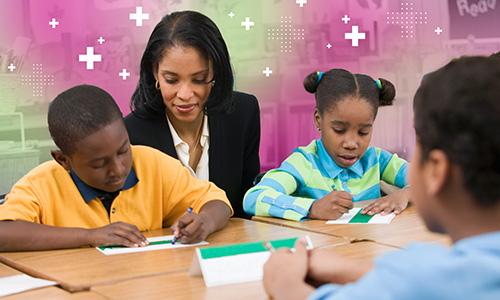This is the fifth post in a series about building trajectory-based performance tasks. Stay tuned for follow-up posts, and watch our on-demand webinar on this topic.

We hope you’re becoming more comfortable using trajectory-based performance tasks to teach complex concepts in your classroom.
More modern views of how deep learning occurs indicate we must ask students to use and apply accumulated knowledge so that they have opportunities to practice problem solving and transfer. Trajectory-based performance tasks are designed to provide multiple opportunities for students to learn by doing. They are important in all content areas, but their development in science requires some additional considerations.
In this, the fifth post in our series, we’ll guide you through why complex tasks in science and learning sciences are especially important, as Christopher Harris et al. explain in their April 2019 article.
The case for science trajectory-based performance tasks
The Next Generation Science Standards (NGSS) may be thought of as the broad learning goals for students at each grade level. States often desire these standards to cue instruction in ways that emphasize active scientific reasoning.
Phenomena are not just the initial hook to get students engaged in the process of science. They provide a pathway for students to engage deeply with the material.”
Performance expectations found in the NGSS are meant to provide examples of ways the three-dimensional standards could be integrated on an assessment. The accumulation of disciplinary core ideas is necessary—but not sufficient—to be proficient in the NGSS, however. The guidelines are, instead, a springboard for the inquiry that activates students thinking like scientists.
The NGSS focuses on the use of phenomena to provide context and engagement for students. High-quality performance tasks are connected to real life and the world outside of school. When beginning to explore the role of phenomena in your science classroom, it helps to start by understanding what a phenomenon is and how it can change instruction.
What is a phenomenon?
Phenomena are observable events that cause a student to wonder or otherwise engage with the process of science. The observations do not have to be seen by the naked eye but may be recorded by instruments. They are also specific observable events. For example, stars, as a general topic, are not phenomena. A solar flare that disrupts communications on Earth is. Why? Because it generates a problem that requires an engineering solution.
Using phenomena as the context for a performance task allows students to build confidence in approaching science as a process rather than discrete bits of knowledge.”
Phenomena are not just the initial hook to get students engaged in the process of science. They provide a pathway for students to connect deeply with the material, generating lines of inquiry to make sense of the phenomenon or solve a problem. Using phenomena as the context for a performance task allows students to build confidence in approaching science as a process rather than discrete bits of knowledge.
How do phenomena change instruction?
The change from scientific investigations in which students practice processes using scientific equipment (often with very concrete, specific steps) to exploring phenomena means that students are more involved in a range of scientific activities. There are several benefits to taking this approach:
- Phenomena that are of high interest can lead students to ask “Why?” or “What’s going on?” Once engaged, students become the drivers of their own learning of grade-level content because they’re motivated by compelling, deep questions that support investigating and learning about disciplinary core ideas. As their teacher, you can facilitate student thinking in the classroom by helping them refine their questions and eliciting their background knowledge.
- Conceptualizing instruction in this way changes the learning target from memorization about a topic to figuring out how and why something happens, or solving problems. Explaining a phenomenon requires more than just taking a simple quiz to determine understanding; it’s a process, from asking questions and designing experiments to working with evidence and communicating explanations.
- As students see how information and skills learned in one phenomenon can be transferred to another, they learn to generalize these processes and can use them in any situation. Selecting phenomena that are culturally or personally relevant to students shows them how science impacts them and their communities.
Phenomena, in short, are the entry point and reason that students enter and learn about grade-appropriate disciplinary core ideas, science and engineering practices, and cross-cutting concepts.
Stay tuned
Check back soon for another post where we’ll walk you through how to build trajectory-based performance tasks in your science classroom.
Paul Nichols coauthored this post. He joined NWEA as director of Assessment Design in 2019. Earlier in his career, he worked at ACT, the Center for Next Generation Learning and Assessment at Pearson, and the National Center for the Improvement of Educational Assessment. Dr. Nichols specializes in writing about and researching the design of assessments targeting complex thinking. He holds a PhD and an MA in educational psychology from the University of Iowa.








